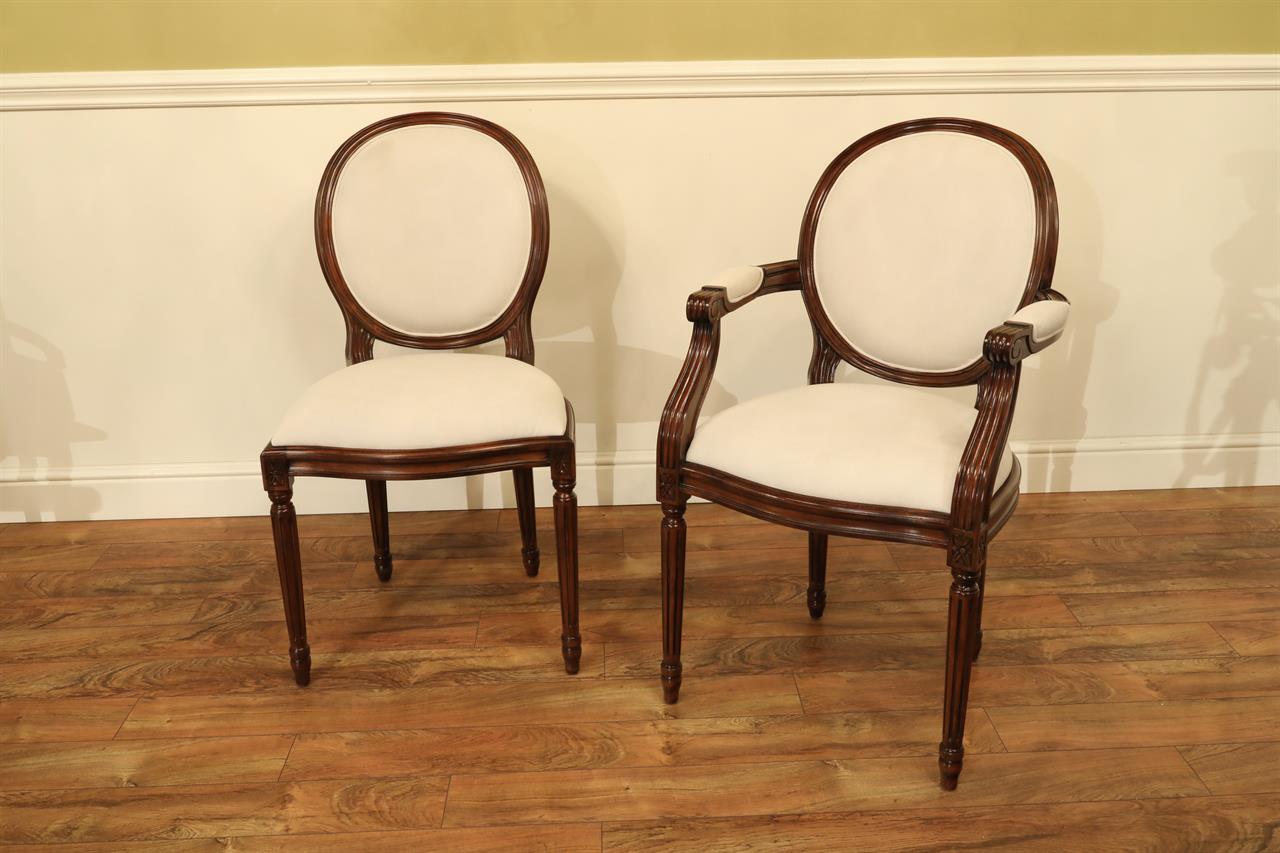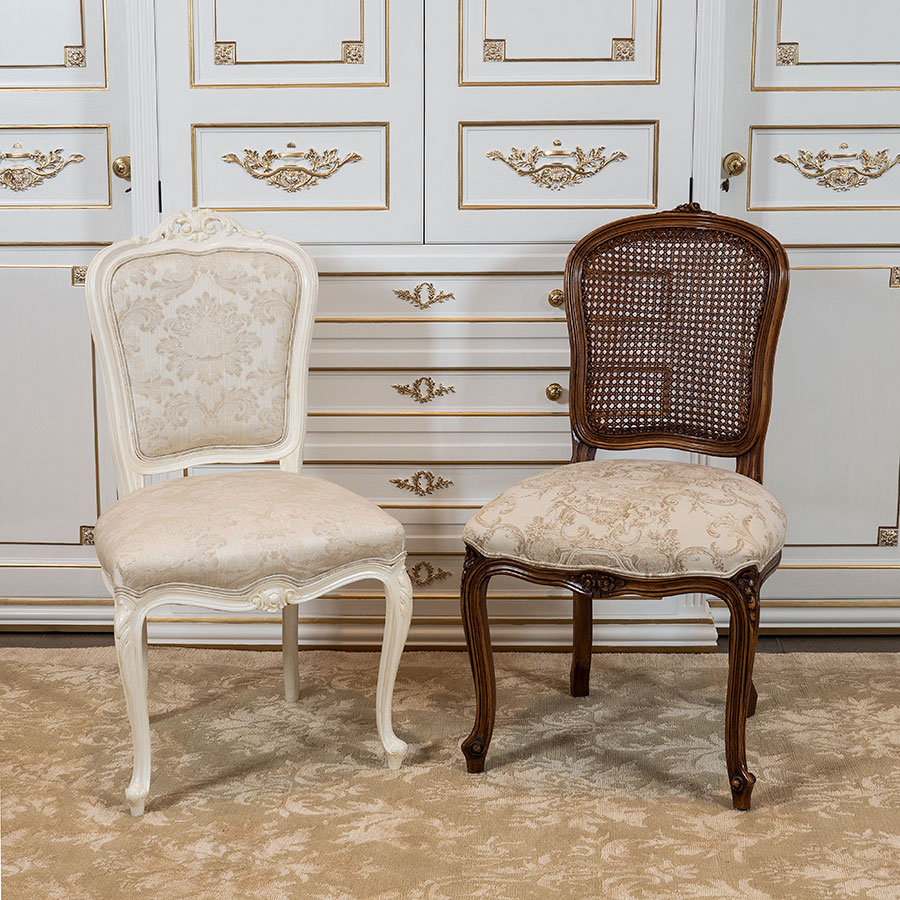The French Round Back Dining Chair

The French round back dining chair, a timeless design that has graced dining rooms for centuries, embodies elegance and sophistication. This iconic piece of furniture has evolved over time, but its core design elements have remained consistent, reflecting the enduring appeal of its classic form.
Origins and History
The French round back dining chair’s origins can be traced back to the 17th and 18th centuries, during the reign of Louis XIV and Louis XV. The French aristocracy, known for their lavish lifestyle, commissioned skilled artisans to create exquisite furniture that showcased their wealth and status. The round back chair, with its graceful curves and intricate details, became a symbol of this era’s refined taste.
Key Design Elements
The defining features of the French round back dining chair include:
- Rounded Back: The most distinctive element, the rounded back provides both visual appeal and comfort. It creates a sense of intimacy and invites the user to relax. The curve of the back often features intricate carvings or upholstery details, adding to its aesthetic appeal.
- Curved Legs: The legs of the French round back dining chair are typically curved, adding to its elegant and graceful silhouette. These curves can be subtle or dramatic, depending on the chair’s style and era.
- Upholstery Options: The upholstery of the French round back dining chair is highly variable, offering a wide range of possibilities. From luxurious fabrics like velvet and silk to more durable options like leather and linen, the choice of upholstery can significantly impact the chair’s overall appearance and feel.
Famous Designers and Periods
The French round back dining chair has been popularized by numerous famous designers and periods, including:
- Louis XIV: The era of Louis XIV (1643-1715) saw the rise of the French Baroque style, characterized by its opulence and grandeur. Chairs from this period often featured elaborate carvings, gilded frames, and luxurious upholstery.
- Louis XV: During the reign of Louis XV (1715-1774), the Rococo style emerged, emphasizing elegance and asymmetry. Chairs from this period often featured graceful curves, delicate carvings, and pastel colors.
- Thomas Chippendale: A renowned English furniture maker, Thomas Chippendale (1718-1779), incorporated elements of the French round back chair into his designs, creating a fusion of French elegance and English craftsmanship.
Variations and Evolution of the French Round Back Dining Chair

The French round back dining chair, a timeless piece of furniture, has undergone significant variations and evolution throughout its history, reflecting changing tastes, materials, and manufacturing techniques. From its humble beginnings to its sophisticated modern interpretations, this chair has consistently adapted to the needs and desires of its time.
Materials Used in Construction
The materials used in constructing French round back dining chairs have varied significantly over the centuries, reflecting both economic and stylistic trends.
- Wood: Traditionally, hardwoods like oak, walnut, and cherry were favored for their durability and aesthetic appeal. These woods were often hand-carved with intricate details, showcasing the craftsmanship of the era. The choice of wood often reflected regional availability and economic factors. For example, oak was prevalent in northern France, while walnut was more common in the south.
- Metal: The use of metal, particularly wrought iron, became more prominent in the 19th century, allowing for more elaborate and lightweight designs. Iron was often used for the chair’s frame, while the seat and back were upholstered. This combination offered both structural strength and decorative elegance.
- Upholstery Fabrics: Upholstery fabrics have also evolved over time. Early chairs were often covered in simple linen or wool, but as textile production advanced, more luxurious materials like velvet, brocade, and tapestry became available. These fabrics added a touch of opulence and sophistication to the chair’s design, reflecting the social status of the owner.
Evolution of Design
The French round back dining chair has undergone a remarkable evolution in design, reflecting changing artistic trends and social conventions.
- 17th and 18th Centuries: Chairs from this period often featured ornate carvings, intricate upholstery, and elegant proportions. Styles like the Louis XIV and Louis XV chairs exemplified the grandeur and sophistication of the French court. These chairs were often made with elaborate floral motifs, shell-like curves, and intricate rococo designs.
- 19th Century: The 19th century saw a shift towards more simplified and functional designs. The Empire style, inspired by classical Roman and Greek architecture, featured straight lines, geometric patterns, and a focus on symmetry. The use of metal became more prevalent, allowing for lighter and more affordable designs.
- 20th Century and Beyond: The 20th century brought a wide range of styles, from the Art Deco movement’s bold geometric patterns and sleek lines to the mid-century modern aesthetic’s emphasis on functionality and simplicity. Contemporary designs often incorporate innovative materials and manufacturing techniques, while still drawing inspiration from traditional French styles.
Regional Variations
The French round back dining chair exhibits distinct regional variations, reflecting local traditions and preferences.
- Provence: Chairs from Provence often feature rustic charm and a focus on natural materials. They are frequently made with local hardwoods like olive wood or walnut, and the upholstery may incorporate floral patterns and earthy tones. The overall design is characterized by simplicity and functionality, reflecting the region’s agricultural heritage.
- Paris: Parisian chairs tend to be more sophisticated and elegant, often featuring intricate carvings and luxurious upholstery. The use of gilded wood and luxurious fabrics like velvet and brocade is common, reflecting the city’s reputation for fashion and refinement. These chairs often showcase the craftsmanship of Parisian artisans, who have long been renowned for their exquisite work.
The French Round Back Dining Chair in Contemporary Interiors

The French round back dining chair, with its timeless elegance and enduring appeal, has seamlessly transitioned into contemporary interiors, adding a touch of classic charm to modern spaces. Designers are finding innovative ways to incorporate this iconic style into diverse design themes, showcasing its versatility and adaptability.
The French Round Back Dining Chair in Modern Home Decor
The French round back dining chair’s presence in modern home decor is a testament to its enduring appeal. Its graceful curves and intricate details create a sense of sophistication and refinement, even in minimalist or industrial settings. This chair’s ability to complement diverse styles stems from its versatility in materials and finishes. Contemporary interpretations often feature sleek, minimalist designs, using materials like metal, leather, or upholstered fabrics. These variations allow the chair to integrate seamlessly into modern aesthetics, offering a harmonious blend of classic and contemporary elements.
Incorporating the French Round Back Dining Chair into Interior Design Themes
The French round back dining chair’s adaptability extends to its seamless integration into various interior design themes.
- Farmhouse: In farmhouse interiors, the French round back dining chair adds a touch of rustic elegance. The chair’s natural wood finishes, often paired with distressed paint or a simple linen upholstery, complement the farmhouse aesthetic. The chair’s gentle curves provide a sense of comfort and warmth, while its classic design adds a touch of sophistication.
- Bohemian: In bohemian interiors, the French round back dining chair contributes to the eclectic and layered aesthetic. Bohemian interpretations often feature bold colors, intricate patterns, and mixed materials. The chair’s classic design serves as a grounding element, while its intricate details complement the bohemian spirit.
- Minimalist: In minimalist interiors, the French round back dining chair offers a touch of elegance and refinement without overwhelming the space. Minimalist interpretations often feature clean lines, neutral colors, and simple materials. The chair’s graceful curves and subtle details add a touch of visual interest without compromising the minimalist aesthetic.
The French Round Back Dining Chair’s Impact on Contemporary Furniture Design
The French round back dining chair has had a significant impact on contemporary furniture design. Its enduring popularity has inspired designers to reinterpret its classic form, resulting in a wide range of variations that incorporate modern materials, finishes, and design elements. This ongoing evolution ensures that the French round back dining chair remains a relevant and sought-after piece in contemporary interiors.
The French round back dining chair, with its elegant curves and timeless appeal, often evokes a sense of nostalgia. While its woven rattan seat may offer a rustic charm, it can sometimes lack the comfort needed for extended dining experiences.
To remedy this, one can explore the world of rattan dining chair cushions , which offer both plush support and a touch of personalized style. These cushions can transform the chair into a haven of comfort, allowing you to linger over meals and savor the company of loved ones, just as the French round back dining chair was originally intended.
The French round back dining chair, with its elegant curves and timeless design, whispers of a bygone era, a time of leisurely dinners and heartfelt conversations. Yet, even in our fast-paced world, there’s a certain comfort in its embrace, a feeling of being gently cradled.
Perhaps that’s why the sleek and modern black faux leather tub chair and footrest also holds a similar appeal, offering a sense of sanctuary amidst the chaos. The French round back dining chair, however, carries the weight of history, its worn patina telling tales of laughter and tears, a silent testament to the enduring power of simple beauty.
